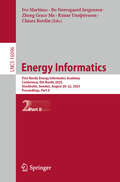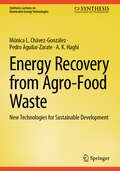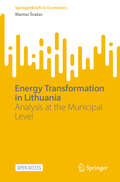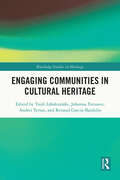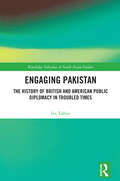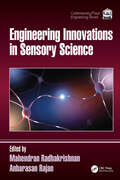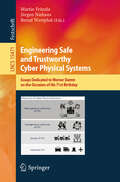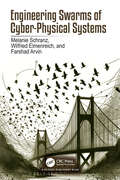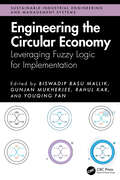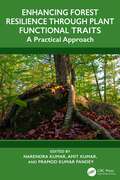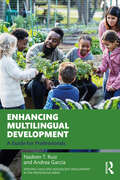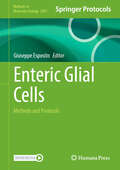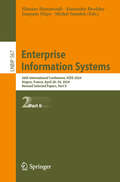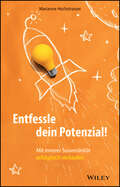- Table View
- List View
Energy Informatics: First Nordic Energy Informatics Academy Conference, EIA Nordic 2025, Stockholm, Sweden, August 20–22, 2025, Proceedings, Part I (Lecture Notes in Computer Science #16095)
by Bo Nørregaard Jørgensen Zheng Grace Ma Ivo Martinac Rúnar Unnþórsson Chiara BordinThis book constitutes the proceedings of the First Nordic Energy Informatics Academy Conference, Nordic EIA 2025, which took place in Stockholm, Sweden, in August 2025. The 43 full papers and 8 short papers accepted were carefully reviewed and selected from 65 submissions. They were organized in topical sections as follows: Part I: Energy Forecasting and Intelligent Control Systems; District HEating, Thermal Systems, and Retrofit Strategies; Building Simulation, Urban Energy, and Environmental Sensing; Industrial Process Efficiency and Biomass Utlilzation; Energy Informatics for Electric Vehicles and Mobility Systems; Multi-Agent Systems and Local Market Coordination; Part II: Policy, Metrics, and Infrastructure Performance; Smart Buliding Systems and Semantic Data Integration; Prosumer Optimization and Energy Storage in Local Energy Communities, Grid-Oriented AI, Simulation, and Resilience; Non-Intrusive Load Monitoring and Data Competitions.
Energy Informatics: First Nordic Energy Informatics Academy Conference, EIA Nordic 2025, Stockholm, Sweden, August 20–22, 2025, Proceedings, Part II (Lecture Notes in Computer Science #16096)
by Bo Nørregaard Jørgensen Zheng Grace Ma Ivo Martinac Rúnar Unnþórsson Chiara BordinThis book constitutes the proceedings of the First Nordic Energy Informatics Academy Conference, Nordic EIA 2025, which took place in Stockholm, Sweden, in August 2025. The 43 full papers and 8 short papers accepted were carefully reviewed and selected from 65 submissions. They were organized in topical sections as follows: Part I: Energy Forecasting and Intelligent Control Systems; District HEating, Thermal Systems, and Retrofit Strategies; Building Simulation, Urban Energy, and Environmental Sensing; Industrial Process Efficiency and Biomass Utlilzation; Energy Informatics for Electric Vehicles and Mobility Systems; Multi-Agent Systems and Local Market Coordination; Part II: Policy, Metrics, and Infrastructure Performance; Smart Buliding Systems and Semantic Data Integration; Prosumer Optimization and Energy Storage in Local Energy Communities, Grid-Oriented AI, Simulation, and Resilience; Non-Intrusive Load Monitoring and Data Competitions.
Energy Management Strategies for Multi-Vectored Energy Hubs to Achieve Low Carbon Societies
by Sanjeevikumar Padmanaban Rupendra Kumar Pachauri Sivaraman Palanisamy Sharmeela Chenniappan Jai Govind Singh Shubham TiwariComprehensive reference on multi energy hub (MEH) modeling, management, protection, and trading across energy exchange markets with supporting case studies Energy Management Strategies for Multi-Vectored Energy Hubs to Achieve Low Carbon Societies discusses the complex exchange process across different sources within an evolving set of technologies, presenting multi-vectored energy hub (MV-EH) modeling techniques and associated energy management strategies for their network architecture. This includes in-depth assessments of advanced energy conversion technologies, market mechanisms, and transactive energy management to ensure robust and flexible energy-sharing mechanisms. The book focuses on renewable energy integration in MV-EHs, advanced energy storage, and advance energy conversion technologies. Later chapters cover detailed analyses of Power-to-X (P2X) technologies, bioenergy integration, and emerging challenges in high-renewable penetration in energy hubs. Case studies of MV-EHs explore the latest advancements such as the carbon tax mechanism, carbon trading strategies, the role of hydrogen generation, and carbon storage to enhance MV-EH performance. Readers will find insights into the integration of carbon reduction techniques (CDR) and emission trading mechanisms, along with the role of bioenergy in building the low emission energy systems. Mathematical models of various new energy conversion systems such as power to gas (P2X), hydrogen storage, and hydrogen usage are also explored. Edited by a team of highly qualified authors, this book covers additional topics such as: Types of frameworks to manage network energy hubs, cooperative and non-cooperative strategies, and centralized, decentralized, and distributed system architectures Advanced energy conversion units such as electric heat pumps, combined heat and power units, gas boilers, absorption chillers, electric chillers, and energy storage units The role of bioenergy, power-to-X, hydrogen, carbon reduction techniques (CDR), carbon taxes, carbon market, and trading strategies in achieving low energy systems Technologies to enhance flexibility in MEHs such as electrical, heating, cooling, and community demand response programs The impact of high or full share of renewables and load-side uncertainties on MV-EH operations Delivering a thorough understanding of networked multi-vectored energy systems, and their role in sustainable energy transitions, Energy Management Strategies for Multi-Vectored Energy Hubs to Achieve Low Carbon Societies is an essential reference for engineers, researchers, and graduate students developing energy systems, smart grids, and decarbonization strategies.
Energy Recovery from Agro-Food Waste: New Technologies for Sustainable Development (Synthesis Lectures on Renewable Energy Technologies)
by A. K. Haghi Mónica L. Chávez-González Pedro Aguilar-ZarateAs is well known, fossil fuels and food waste are significant contributors to the climate change crisis. Conversion of food waste to energy can help solving or mitigating these problems by providing a sustainable energy alternative to fossil fuels. This book provides an overview of technologies to convert food waste to energy. It explains the rationale behind this approach and describes different methods of turning food waste into energy, factors affecting the productivity of these processes, and the advantages and challenges of these technologies. Current research in the field and selected case studies are also described.
Energy Transformation in Lithuania: Analysis at the Municipal Level (SpringerBriefs in Economics)
by Mantas ŠvažasThis open access Brief investigates the issue of energy transformation in small countries without their own fossil resources. Using Lithuania as a case study, the Brief analyses energy transformation from both a municipal and regional perspective, outlining the reasons for pursuing energy transformation, the main constraints that exist, and proposing practical methodologies for assessing local energy potential. The chapters focus on real-world challenges, including political barriers and competence gaps, while also making concrete policy recommendations and offering models for energy transformation in regional areas. Filling a critical gap in the discourse on municipal energy transformation, this Brief will be of interest to scholars, researchers, and policymakers in the fields of energy policy, regional development, and sustainability as well as professionals in municipal governance, energy sector decision-makers, and private sector stakeholders interested in decentralized energy solutions.
Energy-Based Safety: A Scientific Approach to Preventing Serious Injuries and Fatalities (SIFs)
by Matthew R. HallowellDespite steady improvements in reducing minor injuries over the past two decades, the rate of serious injuries and fatalities (SIFs) has remained stubbornly flat. Research has revealed that the hazards causing minor injuries are not the same as those leading to fatalities, making traditional safety approaches insufficient. Energy-Based Safety (EBS) presents a science-backed strategy for SIF prevention, built on four core principles that emphasize the role of hazardous energy, the power of effective controls, and the critical influence of workers in shaping safety outcomes.This book is a useful resource for those committed to saving lives and delivering change in workplace safety through new ways of injury prevention. Divided into two parts, it firstly explores the research behind EBS and investigates each principle with evidence, case studies, and practical insights from real-world implementation. The second part focuses on incorporating EBS into existing safety practices, from design and work planning to incident learning and performance measurement.Through reading this book, readers will gain practical tools and methods to enhance safety programs, making SIF prevention effective and sustainable in their workplace. Written for safety professionals, Energy-Based Safety: A Scientific Approach to Preventing Serious Injuries and Fatalities (SIFs) is an enlightening read for industry leaders in occupational health and safety and practitioners responsible for workplace safety and occupational risk.
Engagement with Culture in Transformative Times: Mapping the Societal Drivers and Impacts of Cultural Understandings, Practices, Perceptions, and Values across Europe
by Nete Nørgaard Kristensen Susanne Janssen Marc VerboordAt the heart of this volume are the questions: What does culture mean to European citizens in the face of globalisation, digitalisation, diversity, and social inequality? How do Europeans engage with culture in its various forms, and what societal values are tied to this cultural engagement? These questions are explored in depth across the 15 chapters of this book. By delving into the understandings, practices, perceptions, affordances, and impacts of culture, this book advances the study of the societal values of culture in contemporary European societies, offering insights beneficial to both research and cultural policy work.The book stands out with its five unique features. It embraces an inclusive conception of culture, spanning the arts, popular culture, and everyday cultural practices, both offline and online. It takes a grassroots approach, starting from the cultural understandings and experiences of European citizens. It employs a comparative method involving people from diverse socio-economic groups in nine European countries – with different cultural policy models, social-structural features, socio-cultural value orientations, and media systems. It builds on a multi- and mixed-methods approach, including a large-scale survey, a smartphone study with experimental stimuli, several phases of online content data collection and analysis, qualitative interviews, and focus groups. Finally, it delves into how wide-ranging and interconnected sociocultural transformations such as migration, digitalisation, and social inequality impact people’s understanding of and engagement with culture as well as the meanings and values they attribute to culture. These unique features promise to offer a fresh and comprehensive perspective on cultural engagement in contemporary European societies.The collection showcases the multiple, often contradictory concepts and understandings of culture and its societal values among social groups within and across European societies. The findings call for a “social turn” in cultural policy that extends beyond traditional arts and culture to support diverse cultural expressions that may enhance social values, address complex social issues, and shift the focus from economic objectives to promoting civic solidarity, equity, inclusivity, tolerance, and shared community values.
Engagements with Children’s and Young Adult Literature (Routledge Engagements with Literature)
by Lydia Kokkola Sara Van den BosscheEngagements with Children’s and Young Adult Literature offers an accessible guide to studying Children’s and Young Adult (CYA) literature, teaching readers how to read critically. This book introduces this dynamic field encompassing diverse genres, audiences, and interpretations. Lydia Kokkola and Sara Van den Bossche examine its historical, cultural, and ideological dimensions while addressing adult perspectives and the ambivalence of child agency. Tools for critical analysis, genre-specific insights, and emerging research trends enhance readers’ engagement with CYA literature and its broader implications.The book approaches CYA literature from various complementary angles: Historical: the influence of religious and philosophical convictions on its development; Thematic: commonly-occurring genres and types of CYA literature, such as realism versus speculative fiction; Narratological: plot, time, tension, character, and setting; Visual: the main principles for 'reading' images in picturebooks, graphic novels, and comics; Ideological: power dynamics and common constructions of childhood; Social: questions of identity politics related to race, gender, and orientation, and offers tools to read critically. Engagements with Children’s and Young Adult Literature brings together established theories and new perspectives on CYA literature, combining engagement with theory with hands-on analytical, interpretive, and methodological tools for budding scholars of CYA literature. Exploring a diverse range of writing, this dynamic introduction is an invaluable resource for students and scholars of this vibrant field.
Engaging Communities in Cultural Heritage (Routledge Studies in Heritage)
by Tuuli Lähdesmäki Andrei Terian Johanna Turunen Renaud Garcia-BardidiaThis book explores the concepts and practices of participation and community engagement in cultural heritage, examining the impact of the participatory turn in the heritage sector and the key opportunities and challenges it presents.Participation has become a widely used umbrella term in the discourses of heritage institutions, practitioners, and scholars alike. This participatory turn represents a shift towards the active involvement of communities, stakeholders, and the public in decision-making processes, moving away from traditional top-down approaches towards more inclusive and collaborative models in which diverse voices contribute to cultural heritage. While the pluralisation of heritage narratives, meanings, and practices can sometimes give rise to societal tensions, this book argues that broader participation is essential for unlocking heritage’s transformative potential and future-oriented impetus. The book explores these issues through 15 case studies drawn from across the globe and organised into three thematic sections: social inclusion in heritage practices, the role of digital tools in heritage participation, and participatory heritage management and governance. These case studies contribute to emerging debates on expanding the spaces where heritage participation and community engagement take place.Interdisciplinary in nature, this book is intended for scholars and professionals working on cultural heritage, participation, social inclusion, digitisation, management, and community and audience engagement. It is also well-suited for undergraduate and graduate courses that critically examine heritage participation and community engagement in today’s pluralistic societies.
Engaging Pakistan: The History of British and American Public Diplomacy in Troubled Times (Routledge Advances in South Asian Studies)
by Ian TalbotEngaging Pakistan examines the role of British and American public diplomacy in Pakistan. It focuses on case studies located in two periods (1955–1964 and 2008–2012) during which there was both intense public diplomacy activity and increasing public hostility, particularly towards the United States. Putting forth this juxtaposition of the two periods, the study provides an opportunity for a fine-grain analysis to contribute to wider theoretical and comparative studies of public diplomacy as well as provide valuable empirical material.The author argues that limitations in the effectiveness of public diplomacy arise whenever foreign audiences perceive that a state’s foreign policy actions are illegitimate and inconsistent with its publicly proclaimed values. US unreliability in the 1960s and unilateralism four decades later undermined its soft power, despite the successes of individual public diplomacy initiatives. Anti-Americanism in Pakistan is usually linked with the aftermath of 9/11, but this volume will reveal that public mistrust stretched as far back as the 1960s. The Pakistani public trusted Britain far more, so that even when unpopular policies were adopted, there was not such a steep decline in its standing. Despite less funding, UK public diplomacy initiatives operated in a more favourable environment than that of the United States. The book focuses on five main areas of public diplomacy activities that generate soft power, namely, communication/information activities, educational exchanges and assistance, volunteering, cultural performances and exhibitions and high-profile visitors’ public engagement. These activities are examined in case studies from either a single time frame or covering both periods.A pioneering study of British and American public diplomacy in Pakistan in the early Cold War and later post-9/11 eras, this book will be of interest to researchers on Modern South Asia, international relations, public diplomacy and diplomatic history, as well as those interested in wider subjects ranging from Cold War studies to sports history.
Engineering Innovations in Sensory Science (Contemporary Food Engineering)
by Mahendran Radhakrishnan Anbarasan RajanSensory analysis is significant in food product development, and its importance impacts the maintenance of sensory qualities for food products. While there are many books exploring sensory analysis and its methods, this is the first of its kind to also explore the use of engineering tools and instruments to produce measurable and reliable data. In exploring sensory analysis methods, this book also focuses on the novel computer interface technologies to retrieve human sensory perceptions directly from the human body and convert them into a measurable unit, exploring the present status in computer interface technologies and scope for interventions to overcome obstacles.Mahendran Radhakrishnan attained his PhD in Food Process Engineering from Tamil Nadu Agricultural University, India. Prior to this, he received degrees in Industrial Biotechnology as well as Chemical Engineering. He is presently Professor and Head of Department of Food Process Technology at National Institute of Food Technology, Entrepreneurship and Management, Thanjavur (NIFTEM-T). Dr. Mahendran’s research focus includes Advances in Food Processing Technologies, novel non-thermal processing, including Cold Plasma, High Pressure Processing Applications in Agri-Food, Food Structure & Shape Transformation (4D Printing), and Super Critical CO2 Extraction. Mahendran has authored over 150 publications in reputed journals.Anbarasan Rajan is Food Process Engineer who earned his M.Tech and Ph.D. in Food Process Engineering from the National Institute of Food Technology, Entrepreneurship and Management, Thanjavur (NIFTEM-T). His primary research areas include nonthermal food processing, 4D foods/food shape morphing, and sensory science.
Engineering Mathematics with MATLAB
by Chul Ki Song Jong-Ryeol KimThis textbook takes a streamlined, practical approach, designed to make engineering mathematics accessible and manageable for undergraduate students and instructors alike. Students will gain a fundamental understanding within the scope of a two-semester course.This textbook introduces students to the fundamental principles of engineering mathematics through concise explanations, systematically guiding them from the basics of first-order, second-order, and higher-order ordinary differential equations (ODEs), Laplace transforms, and series solutions of ODEs. It then transitions to more advanced topics, including linear algebra, linear system of ODEs, vector differential calculus and vector integral calculus, Fourier analysis, partial differential equations (PDEs), and concludes with complex numbers, complex functions, and complex integration. The book presents fundamental principles systematically with concise explanations. It features categorized key concepts, detailed solutions, and alternative methods to connect material to prior knowledge. Exercises are thoughtfully organized, balancing problem-solving practice with real-world applications in fields like mechanical engineering, electrical engineering, chemical engineering, and so on. Notably, this book incorporates MATLAB® to enhance understanding. MATLAB-based examples simplify complex calculations, offering visualizations that connect theory and practice. Chapters also include optional advanced topics, providing deeper insights for motivated learners.Designed with practicality in mind, this book offers a balanced approach to mastering engineering mathematics, with a manageable workload aligned to academic schedules. It is an invaluable resource for instructors seeking effective teaching tools and for students aiming to build strong mathematical foundations that they can apply to their own engineering discipline.
Engineering Safe and Trustworthy Cyber Physical Systems: Essays Dedicated to Werner Damm on the Occasion of His 71st Birthday (Lecture Notes in Computer Science #15471)
by Martin Fränzle Jürgen Niehaus Bernd WestphalThis Festschrift is dedicated to Werner Damm, a pioneering researcher and practitioner in cyber-physical systems. Werner received his PhD in 1981 from RWTH Aachen and held the Chairs for Computer Architecture and Safety Critical Systems at Carl von Ossietzky Universität Oldenburg, from where he coordinated foundational research projects such as the Collaborative Research Center Automatic Verification and Analysis of Complex Systems, AVACS, funded by the German Science Foundation. He has been a founder or board member of many projects, associations, companies, and events, including the applied research institute OFFIS; BTC Embedded Systems, providing testing solutions for automotive systems; SafeTRANS, a non-profit industrial and academic association coordinating strategies and knowledge transfer in the area of safety relevant systems; and numerous conferences. He has been a scientific board member or expert advisor to the German Institute for Artificial Intelligence, DFKI; the ECSEL and Artemis public-private partnerships of the European Commission; the German Aerospace Center, DLR; the Helmholtz Association; and the US National Science Foundation. He is a member of the German National Academy of Technical Sciences, acatech. Werner Damm&’s work has spanned mathematical models of embedded systems, systems-of-systems, cyber physical systems, specification languages, hybrid discrete-continuous systems, formal verification methods, automatic synthesis from formal specifications, and analysis of real-time and safety-critical behavior, complemented by applied research with industrial partners in avionics, automotive, space, and medical systems. Throughout his career he has been motivated to render digitally controlled systems safe, societally acceptable, and beneficial. The contributions in this volume reflect how he has inspired many researchers and practitioners across disciplines who share this ambition.
Engineering Science and Technology: Innovations for the Future
by S. R. Reeja Bore Gowda Y. S. Rammohan Ganesan Prabu Sankar G. JayalathaThe International Conference on Recent Innovations in Engineering Science & Technology (ICRIET-2025), hosted by KSIT Bengaluru, brought together researchers and experts from around the world to present 225 peer reviewed papers across four engineering domains. With keynote sessions on AI, energy harvesting, and sustainable manufacturing, the conference promoted interdisciplinary dialogue and cutting-edge innovation. It served as a dynamic platform for academic exchange, fostering collaboration between academia and industry. ICRIET-2025 stands as a testament to KSIT’s commitment to advancing research and technological progress.
Engineering Swarms of Cyber-Physical Systems
by Wilfried Elmenreich Farshad Arvin Melanie SchranzEngineering Swarms for Cyber-Physical Systems covers the whole design cycle for applying swarm intelligence in Cyber-Physical Systems (CPS) and guides readers through modeling, design, simulation, and final deployment of swarm systems. The book provides a one-stop-shop covering all relevant aspects for engineering swarm systems. Following a concise introduction part on swarm intelligence and the potential of swarm systems, the book explains modeling methods for swarm systems embodied in the interplay of physical swarm agents. Examples from several domains including robotics, manufacturing, and search and rescue applications are given. In addition, swarm robotics is further covered by an analysis of available platforms, computation models and applications. It also treats design methods for cyber-physical swarm applications including swarm modeling approaches for CPSs and classical implementations of behaviors as well as approaches based on machine-learning. A chapter on simulation covers simulation requirements and addresses the dichotomy between abstract and detailed physical simulation models. A special feature of the chapters is the hands-on character by providing programming examples with the different engineering aspects whenever possible, thus allowing for fast translation of concepts to actual implementation. Overall, the book is meant to give a creative researcher or engineer the inspiration, theoretical background, and practical knowledge to build swarm systems of CPSs. It also serves as a text for students in science and engineering.
Engineering the Circular Economy: Leveraging Fuzzy Logic for Implementation (Sustainable Industrial Engineering and Management Systems)
by Gunjan Mukherjee Biswadip Basu Mallik Rahul Kar Youqing FanImplementing the circular economy necessitates innovative approaches capable of managing the complexity and uncertainty inherent in the shift from linear to circular systems. Fuzzy logic, a computational approach inspired by human reasoning, provides a promising framework for navigating these complexities. With a practical approach, this book offers how fuzzy logic can be utilized to implement the circular economy.Engineering the Circular Economy: Leveraging Fuzzy Logic for Implementation discusses the significance of incorporating fuzzy logic into circular economy strategies. This integration enables the development of adaptive models for resource management, waste reduction, and supply chain optimization. The book showcases various case studies and practical examples to demonstrate the application of fuzzy logic in implementing circular economy principles across diverse industries. Additionally, it addresses the challenges and future directions within a circular economy framework, emphasizing the importance of identifying these challenges and exploring future directions for continuous improvement in sustainability efforts. The potential of combining engineering, fuzzy logic, and the circular economy to address global sustainability challenges is highlighted, showcasing how leveraging fuzzy logic facilitates informed decision-making and the creation of innovative solutions as we work toward a more sustainable future.With its forward-thinking approach and focus on practical applications, this book is an essential resource for practitioners, researchers, engineers, scholars, and policymakers looking to promote innovation and sustainability in today’s rapidly changing economic and environmentally conscious environment.
English Hippocrene: From Chaucer to Blake
by Deb Narayan BandyopadhyayThis book is a comprehensive introduction to English poetry, tracing its evolution from the Age of Chaucer to the Romantic Period. Designed especially for undergraduate and graduate students who are second-language learners in South and Southeast Asia, it fosters a deeper appreciation of English literary history and its aesthetic foundations.Each chapter offers a well-structured overview, beginning with the historical, social, political, and philosophical contexts that shaped the literature of the time. This is followed by close readings of representative poems, highlighting key themes, poetic forms, and stylistic features. The analytical framework helps learners understand not just the content of the poems, but also the broader cultural forces that influenced their creation and reception.Subjects covered include: Major poets and literary movements from Chaucer to the Romantics Historical and cultural contexts of poetic works Thematic concerns and philosophical underpinnings Guided analysis of selected poems with discussion prompts Ideal for classroom use or independent study, this book is a valuable resource for students seeking both knowledge and inspiration in their study of English poetry.
English for Science Communication (Routledge Applied English Language Introductions)
by Jack PunEnglish for Science Communication introduces English-language knowledge and skills for scientific communication in a range of local and international contexts. It develops students’ ability to locate and critically read a variety of scientific texts and appropriately communicate, through speaking and writing, the findings of scientific projects to both specialist and non-specialist audiences.The book introduces students to common rhetorical structures used in authentic scientific communication, as well as the typical vocabulary and grammar needed to express these structures. Students will learn to evaluate and report the findings of a scientific study using a range of genres, modes, and media formats, including written scientific reports and multimodal scientific documentaries. Introducing how to understand, present, write, and communicate scientific information in English, this practical guide is essential for all students using English in their science degrees, including as a second language.
Enhancing Forest Resilience through Plant Functional Traits: A Practical Approach
by Amit Kumar Narendra Kumar Pramod Kumar PandeyThis book explores the relationship between plant functional traits and the resilience of forest ecosystems. Understanding how these traits influence forest ecosystems has significant implications for conservation, forestry, and ecosystem management. This book explores the intersection of ecology, botany, and forestry, providing a comprehensive guide to using plant functional traits as a tool to advance sustainable forest development as sustainable forest management becomes increasingly important in the face of global environmental challenges.This book also discusses the role that plant functional traits play in ecosystem dynamics and how they support forest resilience. It emphasizes how crucial these characteristics are for dealing with environmental stresses like drought and climate change, as well as how they affect soil interactions, carbon sequestration, and nutrient cycling. By integrating contemporary developments in trait-based research and analytical instruments, this book provides useful tactics for improving forest resilience via sustainable management techniques.Key Features:· A comprehensive overview of the latest advancements in plant functional traits and their role in forest resilience.· Detailed explanations of the anatomical, physiological, and genetic aspects of plant functional traits, emphasizing their importance in tree growth and adaptation.· Insights into how functional traits influence nutrient cycling, carbon sequestration, soil interactions, and responses to environmental stressors like drought and climate change.· Discussion of modern tools and methodologies in trait-based research, along with future directions for integrating functional traits into forest management strategies.· Practical applications of functional traits in conservation, biodiversity management, and sustainable forest management to enhance ecosystem resilience.This book serves as a valuable reference for researchers and academicians studying species composition within forest ecosystems and exploring ways to enhance forest resilience in the context of climate change. It is also suitable as a textbook for graduate, postgraduate, and Ph.D. students in fields such as agriculture, botany, plant physiology, forestry, biotechnology, environmental science, and agroforestry.
Enhancing Multilingual Development: A Guide for Professionals (Applying Child and Adolescent Development in the Professions Series)
by Nadeen T. Ruiz Andrea GarcíaThis accessible volume presents an up-to-date overview of how young children, older youth, and adults develop multilingual proficiencies. Importantly, it highlights an assets view of multilingualism, offering clear recognition that multilingual competencies are both functional and highly valued in communities across the globe.Dispelling common myths, it explores the benefits of multilingualism spanning interpersonal, academic, and professional settings. With these settings in mind, the book provides practical information on how professionals can promote effective communication with colleagues and clients from a variety of language backgrounds. Each chapter comes equipped with a series of true or false statements where you can record your predictions and learn as you read. Chapters cover topics including the economic and cognitive benefits of multilingualism, social influences, the age factor, family bilingualism and optimal teaching and learning conditions. Finally, the book concludes by providing various step-by-step resources for creating optimal conditions that further develop and support multilingualism in your professional field.Containing suggestions for research-based practices in home, school, and professional settings to enhance multilingual development, this book is essential for professionals working with multilingual young children, older youth, and adults, as well as those who require a foundational understanding of multilingualism.
Enhancing Smart Universities with Emotional Intelligence: Competences for Digital Age Learning
by Markus A. Launer Muhammad Shahbaz Shashi Kant GuptaEnhancing Smart Universities with Emotional Intelligence investigates the successful blending of technology innovations and human beings’ emotional intelligence within higher education institutions in the midst of digital transformation. Today’s “smart” universities improve student experiences, expedite administrative procedures, and facilitate individualized learning pathways by integrating a variety of cutting-edge technologies such as machine learning, big data analytics, immersive and wearable learning tools, digital management systems, and cloud computing. But how can leaders and administrators ensure that these advancements don’t come at the expense of positive experiences and relationships among students and faculty? Built from theoretical frameworks, case studies, and empirical research, this book offers a thorough manual for comprehending the crucial nexus of technology and human abilities to enable dynamic and sustainable learning environments. Each chapter is essential for college and university leaders, administrators, and policymakers around the world who are charged with ensuring that human talents and digital technologies are properly balanced for the best possible learning experiences.Chapter 1 of this book is freely available as a downloadable Open Access PDF at http://www.taylorfrancis.com under a Creative Commons Attribution-Non Commercial-No Derivatives (CC BY-NC-ND) 4.0 license.
Enteric Glial Cells: Methods and Protocols (Methods in Molecular Biology #2971)
by Giuseppe EspositoThis detailed volume highlights the heterogeneity and plasticity of enteric glial cells and explores their contributions to both GI homeostasis and disease pathophysiology. Through an interdisciplinary approach, the book brings together expertise from neurobiology, immunology, physiology, pharmacology, and pathology to provide a comprehensive perspective on the enteric nervous system and its glial components. It explores electrophysiological techniques, the relationship between enteric glia and the gut microbiota, advances in immunohistochemistry, the influence of the gut-brain axis on neurodegenerative diseases and mood disorders, and more. Written for the highly successful Methods in Molecular Biology series, chapters include introductions to their respective topics, lists of the necessary materials and reagents, step-by-step and readily reproducible laboratory protocols, and tips for troubleshooting and avoiding known pitfalls. Authoritative and practical, Enteric Glial Cells: Methods and Protocols serves as an ideal guide for understanding enteric glia but also for stimulating new research avenues that could lead to breakthroughs in treating a range of gastrointestinal and neurological disorders.
Enterprise Information Systems: 26th International Conference, ICEIS 2024, Angers, France, April 28–30, 2024, Revised Selected Papers, Part I (Lecture Notes in Business Information Processing #566)
by Joaquim Filipe Slimane Hammoudi Michał Śmiałek Alexander BrodskyThe two volume set LNBIP 566 - 567 constitutes the refereed post-conference proceedings of the 26th International Conference on Enterprise Information Systems, ICEIS 2024, which was held in Angers, France, during April 2024. The 19 full papers and 18 short papers presented were carefully reviewed and selected from 244 submissions. The proceedings also include one invited paper in full paper length. The purpose of the International Conference on Enterprise Information Systems (ICEIS) is to bring together researchers, engineers and practitioners interested in the advances and business applications of information systems, covering different aspects such as Enterprise Database Technology, Systems Integration, Artificial Intelligence, Decision Support Systems, Information Systems Analysis and Specification, Internet Computing, Electronic Commerce, Human-Computer Interaction and Enterprise Architecture.
Enterprise Information Systems: 26th International Conference, ICEIS 2024, Angers, France, April 28–30, 2024, Revised Selected Papers, Part II (Lecture Notes in Business Information Processing #567)
by Joaquim Filipe Slimane Hammoudi Michał Śmiałek Alexander BrodskyThe two volume set LNBIP 566 - 567 constitutes the refereed post-conference proceedings of the 26th International Conference on Enterprise Information Systems, ICEIS 2024, which was held in Angers, France, during April 2024. The 19 full papers and 18 short papers presented were carefully reviewed and selected from 244 submissions. The proceedings also include one invited paper in full paper length. The purpose of the International Conference on Enterprise Information Systems (ICEIS) is to bring together researchers, engineers and practitioners interested in the advances and business applications of information systems, covering different aspects such as Enterprise Database Technology, Systems Integration, Artificial Intelligence, Decision Support Systems, Information Systems Analysis and Specification, Internet Computing, Electronic Commerce, Human-Computer Interaction and Enterprise Architecture.

